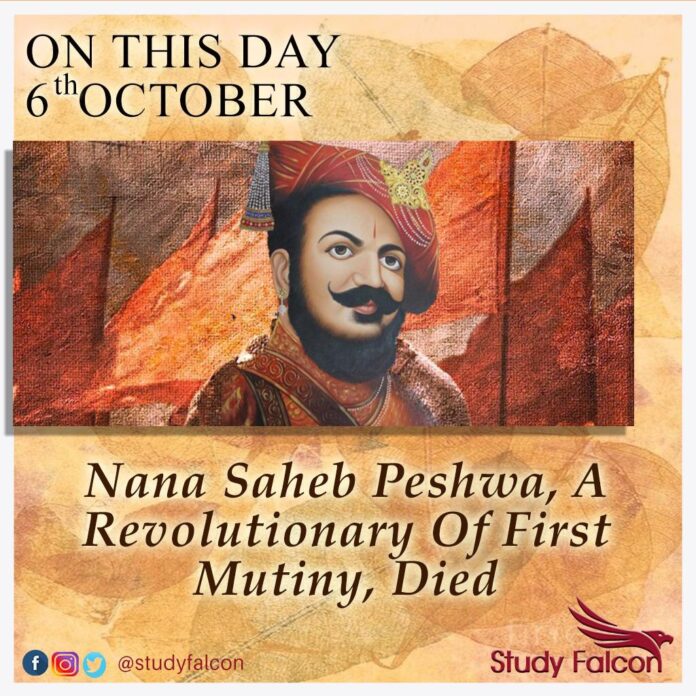Nana Sahib was born as Dhondu Pant, on 19 May, 1924, and was an Indian Peshwa of the Maratha empire. An aristocrat and fighter, he led the rebellion in Cawnpore during the 1857 uprising.
Adopted in 1827 by Baji Rao II, the last Maratha peshwa (ruler), Nana Sahib was educated as a Hindu nobleman. On the death of the exiled Baji Rao in 1852, he inherited the peshwa’s home in Bithur. Although Nana Sahib’s adoptive father had pleaded that his £80,000-a-year life pension be extended to Nana Sahib, the British governor-general of India, Lord Dalhousie, refused the demand of the adoptive father. Nana Sahib believed that he was entitled to a pension from the English East India Company, but the underlying contractual issues are rather murky. Nana Sahib sent an agent, Azimullah Khan, to London to push his claims, but without success. On his return Azimullah told Nana Sahib he was unimpressed by the supposed British military strength in the Crimean War. That report, the refusal of his claim, and threats of the sepoys led him to join the sepoy battalions at Kanpur in rebellion in June 1857. He had sent Sir Hugh Wheeler, commander of British forces at Kanpur, a letter warning of the attack—a sardonic gesture to his former friends. Nana Sahib won the confidence of Charles Hillersdon, the Collector of Kanpur.

It was planned that Nana Sahib would assemble a force of 1,500 soldiers to support the British, in case the rebellion spread to Cawnpore. On 6 June 1857, at the time of the rebellion by forces of the East India Company at Cawnpore, the British contingent had taken refuge at an entrenchment in the northern part of the town. Amid the prevailing chaos in Cawnpore, Nana and his forces entered the British magazine situated in the northern part of the town. However, once he entered the magazine, Nana Sahib announced that he was a participant in the rebellion against the Company, and intended to be a vassal of Bahadur Shah II.
After taking possession of the Company treasury, Nana advanced up the Grand Trunk Road stating that he wanted to restore the Maratha confederacy under the Peshwa tradition, and decided to capture Cawnpore. On his way, Nana met the rebel Company soldiers at Kalyanpur. The soldiers were on their way to Delhi, to meet Bahadur Shah II. Nana wanted them to go back to Cawnpore, and help him defeat the British. The soldiers were reluctant at first, but decided to join Nana when he promised to double their pay and reward them with gold, if they were to destroy the British entrenchment.
A safe conduct given to the British under General Wheeler by Nana Sahib was broken on June 27, and British women and children were massacred at Nana Sahib’s palace. Lacking military knowledge, he could not command the mutinous sepoys, though he had the satisfaction of being declared peshwa in July 1857 by the rebel leader Tantia Tope and his followers after the capture of Gwalior.

The Indian Rebellion leader Nana Sahib became Victorian Britain’s most hated foreign enemy for his part in the 1857 Cawnpore massacres, in which British men, women, and children were killed after having been promised safe passage away from their besieged garrison. Facts were mixed with lurid fiction in reports which drew on villainous oriental stereotypes to depict Nana.
He came to be seen as both a literal and symbolic threat; the arrest of suspects across the years periodically revived the memories and the atavistic fury of the Mutiny, while his example as the Victorians’ archetypal barbaric native ruler shaped broader colonial attitudes. At the same time, he influenced metropolitan perceptions of empire through the popular Mutiny fictions in which he was a larger-than-life villain. Tracing Nana’s changing presence in the British collective memory over generations illustrates the tensions between metropolitan and colonial ideas of empire, and suggests the degree to which an iconic enemy figure could shape perceptions of other races.Defeated by General Henry Havelock and in December 1857 by Sir Colin Campbell, he appointed a nephew, Rao Sahib, to give orders to Tantia. In 1859 Nana Sahib was driven into the Nepal hills, where he is thought to have died.










